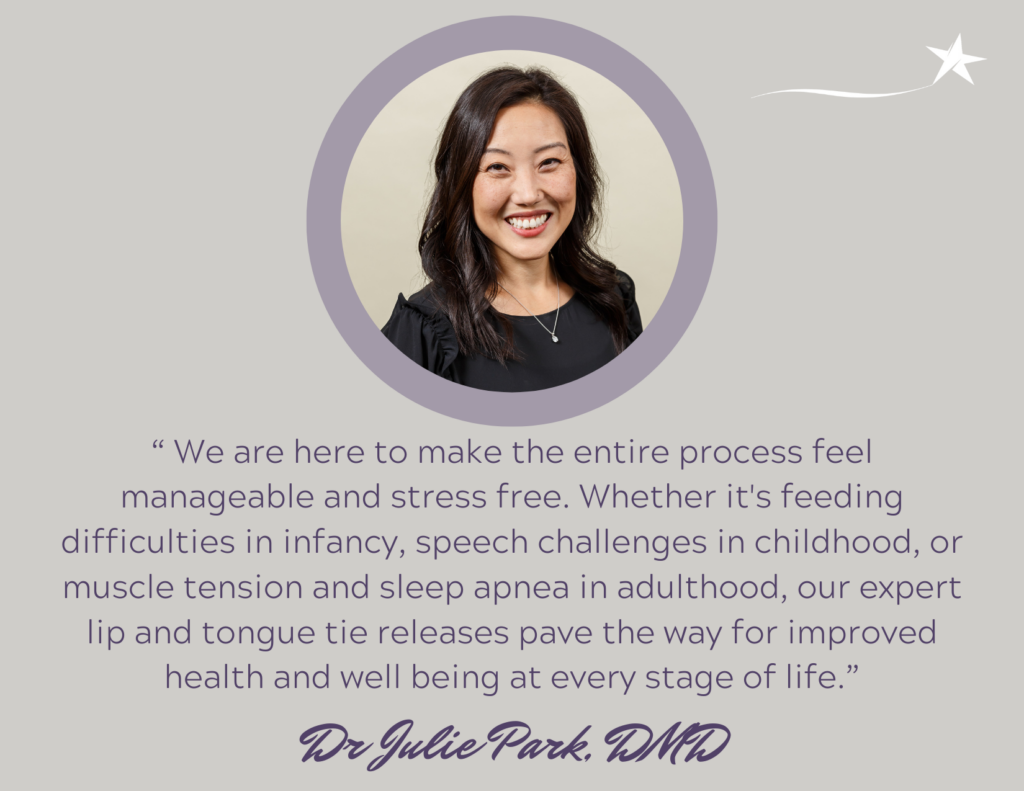FAQ
What is a tongue-tie? What is a lip-tie?
A tongue-tie is a web of thickened tissue in the middle and undersurface of the tongue. A lip-tie is a web of thickened tissue in the middle and undersurface of the upper lip. Ties vary in thickness, length, and position and can restrict proper mobility of the tongue and lip. As a result, ties negatively impact eating, swallowing, speech, and sleep.
What can happen if we don’t treat the tongue tie?
Untreated tongue ties make speaking, eating, swallowing, and sleeping challenging. The longer someone goes with untreated ties, the more compensations their body produces. It becomes harder and harder to remove the bad habits with age.
What are compensations?
Compensations are negative habits that come as a result of a tongue tie. Some examples could be forward posturing, grinding teeth, tongue thrusts, and open mouth breathing to open the airway. In addition, it looks like flattened gums or blistered lips for infants because the baby uses their gums and lips to make a seal instead of the tongue when feeding.
I have seen a speech therapist for years, and no one caught this. Why now, and why not leave it?
I, sadly, hear this too often! Unfortunately, knowledge of tongue and lip ties varies among providers, resulting in long-term therapy with little to no progress. In my opinion, if treatment is not improving the condition after six months, there is something deeper that needs attention! The longer someone lives with a tongue tie, the more bad habits (i.e., compensations) form. So, the quicker it is addressed, the easier it is to remove the compensations.
Why do you work with therapists?
I work with therapists because we are both pieces of a giant puzzle. Therapy is essential to long-term success after a release. Think about having your torn ACL repaired and how important physical therapy builds strength. The same goes for a tongue release and the treatment involved before and after to strengthen and lengthen the tongue muscles.
THE PROCEDURE FAQ:
How do you release the tongue? How long does the procedure take?
I use my laser to gently erase this tight tissue in the midline of the lip or tongue. A lip-tie release takes less than 30 seconds, while a tongue-tie release can take up to 5 minutes. When stitches are placed, this can add 15 minutes. Anyone over the age of 5 receives stitches which improves healing.
Is the procedure painful?
I always place a numbing cream on all ties before release. For an older child or adult, I will also add local anesthesia. Once I confirm the patient is comfortably numb, I begin the quick procedure; it takes less than 5 minutes!
Can parents come back for the procedure?
Parents are welcome to bring the child to the room at the beginning of the appointment. After comfortably positioning the child, the parents will be escorted to the reception area while we perform the quick procedure. Immediately afterward, the parents return to demonstrate the stretching exercises.
Are there potential complications after a release?
Bleeding or infection are possible but extremely rare. In my personal experience, no patient has ever had a bleeding-related complication. The treated area immediately stops bleeding with nursing or bottle feeding in infants. I’ve only seen one child experience an infection that required antibiotics and no further treatment.
RECOVERY FAQ:
What happens after the procedure? How long is recovery?
After the procedure, you are sent home with detailed instructions on aftercare stretches. Most patients do best with Tylenol or Motrin for three days following the procedure to manage any discomfort. The tongue and lips are most sensitive the first three days when stretching and exercising, so these medications are beneficial during this period. After the first week, there is minimal to no discomfort when stretching, and I will see you back at this time to visualize healing. After that, oral exercises will continue for a total of four weeks.
How long will it take to see results?
There is variation in how quickly we see results. Results depend on age and the impact the tongue tie had on the function of the individual patient. For instance, we see more immediate (some even same day) results in infants who came with latching difficulties. However, older children and adults who experience speech delays or sleep apnea may take longer to see results because it takes extra time to retrain the tongue.
SCHEDULING FAQ:
Can you get same-day treatment, or do we have to schedule back?
When the patient comes to the consult with a referral from a preferred provider (oral myofunctional therapist, lactation consultant, speech therapist), there is the option to release the frenum the same day. We recognize that bringing an infant or toddler to appointments can be challenging, so we try to accommodate as much as we can in one visit. However, in cases where sedation is the best treatment option, we will schedule the procedure for another day. If you need help reaching a preferred provider, call 614-636-0338 and we will help!
 Let us help you improve your daily life and daily function with a simple tongue and lip tie release! Schedule a consultation to discuss our frenectomy procedure by calling 614-636-0338.
Let us help you improve your daily life and daily function with a simple tongue and lip tie release! Schedule a consultation to discuss our frenectomy procedure by calling 614-636-0338.
How do I schedule?
